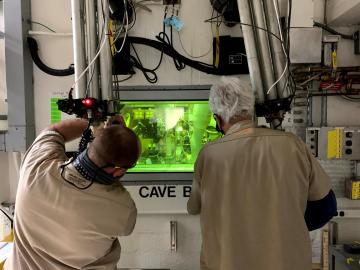
Filter News
Area of Research
News Topics
- (-) Bioenergy (13)
- (-) Biomedical (10)
- (-) Cybersecurity (5)
- (-) Frontier (4)
- (-) Isotopes (12)
- (-) Microscopy (10)
- 3-D Printing/Advanced Manufacturing (27)
- Advanced Reactors (2)
- Artificial Intelligence (7)
- Big Data (5)
- Biology (23)
- Biotechnology (5)
- Buildings (13)
- Chemical Sciences (7)
- Clean Water (8)
- Composites (6)
- Computer Science (30)
- Coronavirus (10)
- Critical Materials (5)
- Energy Storage (21)
- Environment (39)
- Exascale Computing (2)
- Fusion (9)
- Grid (10)
- High-Performance Computing (19)
- ITER (4)
- Machine Learning (1)
- Materials (32)
- Materials Science (24)
- Mathematics (1)
- Mercury (3)
- Nanotechnology (10)
- National Security (7)
- Neutron Science (20)
- Nuclear Energy (9)
- Physics (3)
- Polymers (5)
- Quantum Computing (5)
- Quantum Science (12)
- Security (3)
- Space Exploration (6)
- Statistics (1)
- Summit (9)
- Transportation (21)
Media Contacts

Rich Giannone uses bioanalytical mass spectrometry to examine proteins, the primary driver in biological systems.

When COVID-19 was declared a pandemic in March 2020, Oak Ridge National Laboratory’s Parans Paranthaman suddenly found himself working from home like millions of others.

The Accelerating Therapeutics for Opportunities in Medicine , or ATOM, consortium today announced the U.S. Department of Energy’s Oak Ridge, Argonne and Brookhaven national laboratories are joining the consortium to further develop ATOM’s artificial intelligence, or AI-driven, drug discovery platform.

A rare isotope in high demand for treating cancer is now more available to pharmaceutical companies developing and testing new drugs.

Oak Ridge National Laboratory was among an international team, led by Lawrence Livermore National Laboratory, who synthesized 108 elevated carbon dioxide, or CO2, experiments performed in various ecosystems to find out how much carbon is

Scientists have found new, unexpected behaviors when SARS-CoV-2 – the virus that causes COVID-19 – encounters drugs known as inhibitors, which bind to certain components of the virus and block its ability to reproduce.

Researchers at Oak Ridge National Laboratory have identified a statistical relationship between the growth of cities and the spread of paved surfaces like roads and sidewalks. These impervious surfaces impede the flow of water into the ground, affecting the water cycle and, by extension, the climate.

A new method developed at Oak Ridge National Laboratory proves one effort’s trash is another’s valuable isotope. One of the byproducts of the lab’s national plutonium-238 production program is promethium-147, a rare isotope used in nuclear batteries and to measure the thickness of materials.

Balendra Sutharshan, deputy associate laboratory director for operational systems at DOE’s Pacific Northwest National Laboratory, has joined ORNL as associate laboratory director for the Isotope Science and Engineering Directorate.
A study by Oak Ridge National Laboratory, the University of Copenhagen, the National Park Service and the U.S. Geological Survey showed that hotter summers and permafrost loss are causing colder water to flow into Arctic streams, which could impact sensitive fish and other wildlife.


